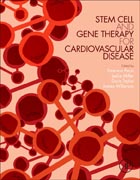
Stem Cell and Gene Therapy for Heart Failure is a state-of-the-art reference that combines the both the breadth and depth of information available in one place. Stem cell and gene therapy is the most cutting edge therapy currently available for patients with heart failure and the therapy has progressed to availability in multiple clinical trials. Each section of this resource includes trials from contributors and specialists from around the world that have been completed to date as well as planned for the future, making this an important resource for cardiology researchers, basic science clinicians, fellows, residents, students, as well as industry. Includes coverage of the three areas with the greatest clinical trials to date: Chronic Limb Ischemia, Chronic Angina, and Acute MI.Provides the current understanding of harnessing the body's native repair mechanisms.Offers future perspectives outlining prospective directions, new trials and exploring unanswered questions. INDICE: Introduction: PART I: STEM CELLS Section I. Body's Native Repair MechanismsChapter 1. Evolution of our understanding of the mechanisms of repairChapter 2. Paracrine MechanismsChapter 3: Lessons from Zebrafish and other modelsChapter 4. Angiogenesis vs Myogenesis Chapter 5: Genes as the ultimate effectors of repairSection II: Autologous Cells for CV disease- pre-clinical and Clinical trials Chapter 1: Bone Marrow Mononuclear CellsChapter 2: Bone Marrow CD 34+ fractionChapter 3: Other Bone Marrow fractions-CD-133+ cellsChapter 4: Skeletal MyoblastsSection III: Clinical Trials for Specific CV DiseasesChapter 1: Chronic Limb IschemiaChapter 2: Chronic/Refractory AnginaChapter 3: Acute Myocardial InfarctionChapter 4: Heart FailureChapter 5: Impact of Cell Preparation on Clinical OutcomesSection IV: Impact of Age on Autologous Stem Cell TherapyChapter 1: Observations from Preclinical modelsChapter 2: Decline in Stem Cell numbers with advancing ageChapter 3: Mechanisms of Limitations of Older Age Chapter 4: Role of Telomere Shortening Chapter 5: New Solutions to solve this potential limitationSection V: Allogeneic Alternatives to Autologous Bone MarrowChapter 1: Alloreactivity and antibody formation with an allogeneic sourceChapter 2: Immuno-Privilege of the Mesenchymal Stem Cell Chapter 4: Clinical Trials to date with MSCsChapter 5: Allogeneic vs Autologous MSCs: pre-clin and trial dataChapter 5: Potential for synergy of MSCs with native progenitor cellsSection VI: Alternative Tissue Sources of Stem Cells Chapter 1: Adipose Tissue-Pre-clinical and Clinical Trial dataChapter 2: Umbilical Cord: Pre-clinical anc Clinical Trial dataChapter 3: Placenta: Pre-Clinical and Clinical Trial dataChapter 4: Menstrual Blood: Pre-Clinical and Clinical Trial dataSection VII: Cardiac Progenitor CellsChapter 1: Lineage Specific Progenitor Cells in all OrgansChapter 2: Surface markers and location of Cardiac Progenitor CellsChapter 3: Lineage Specific vs Multipotent capabilityChapter 4: C-Kit+ cells: Pre-clinical and clinical trial dataChapter 5: Cardiospheres: Pre-clinical and clinical trial dataChapter 6: Isla+ cells: Pre-clinical dataSection VIII. Genetic Engineering/Cell Transformation Chapter 1: Skin vs Cardiac Fibroblast as source Chapter 2: Types of genes/transcription factors usedChapter 3: Transformation to cardiac MSCs: Pre-clinical and Clin TrialsChapter 4: Transformation to Inducible Pleuripotent Stem Cells: Chapter 5: Transformation to MAPC's: Chapter 6: Removing cell memory and transformation modelsSection IX: Routes of Delivery Chapter 1. Homing signal and acute vs chronic disease statesChapter 2. Epicardial InjectionChapter 3. IntracoronaryChapter 4. EndocardialChapter 5. RetrogradeChapter 6. Epicardial PatchSection X: Increasing Cell Viability StrategiesChapter 1: Current survival after implantChapter 2: Biospheres Chapter 3: Epicardial PatchPart II. GENE THERAPYSection 1. Basis for use as primary therapy Chapter 1: Pre-clinical Identification of target genesChapter 2: Mechanisms of Action for Heart FailureSection 2. Inotropic Effect: Chapter 1: SERCA-2aChapter 2: NeuregulinChapter 3: Adenyl CyclaseSection 3: Non-Inotropic: Chapter 1: SDF-1Section 4: Gene vs Stem Cell Therapy Part III. TISSUE ENGINEERINGChapter 1: Advantages over cell or gene therapy Chapter 2: Organogenesis Chapter 3. Scaffolds for new organs Chapter 4. Matrix aloneChapter 5. Matrix plus cells Chapter 6. Biomaterial: Alginate Part IV: FUTURE DIRECTIONSChapter 1: Trials in Non-Ischemic etiology Chapter 2: Multiple Dosing Strategies-rationale and trial designChapter 3: Signature of Responders-lessons from biorepositoryChapter 4: Use of combined cell strategiesChapter 5: Potential for combined gene therapiesChapter 6: Adjunctive therapy with LVADs to increase RecoveryChapter 7: Gene Transfected Stem Cell therapy
- ISBN: 978-0-12-801888-0
- Editorial: Academic Press
- Encuadernacion: Rústica
- Páginas: 608
- Fecha Publicación: 13/10/2015
- Nº Volúmenes: 1
- Idioma: Inglés
